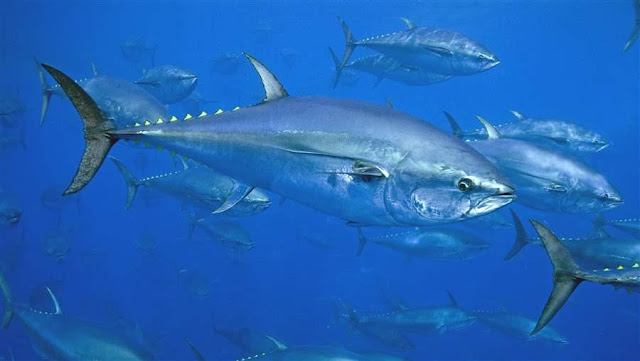Atlantic Bluefin Tuna: A Giant Among Fish
Fish that is super powerful, super-fast, and travels through the Atlantic. Like many other fishes, Atlantic bluefin tuna starts as tiny larvae with few millimeters in length and weighs only a few kilograms. They become sexually mature and grow can lengths up to 3m within three to five years. As tiny larvae, they feed on zooplankton, and their prey increases with the size. While they are newly hatched, the hunt for them is fierce and only a few reach adults. Once they reach the adult stage, they are eaten only by the very largest billfishes, toothed whales, and some open-ocean shark species.
How Can They Survive In Any Extreme Conditions?
Unlike many other cold-blooded fishes, bluefin tuna are warm-blooded. They have a specialized blood vessel structure called countercurrent exchanger, which makes them maintain their body temperatures greater than the surrounding temperatures. This advantage makes them easily and intelligently hunt for their prey in the cold waters.
Swimming in forces can make them find their prey easier, avoid predators, and conserve energy. Bluefin is highly known for the remarkable socialistic behavior, no other species can perform this.
Bluefin tuna fish are highly migratory animals. Their migrations correspond to the spawning behavior and their need for food. To keep eating and growing they embark on a mysterious lifelong migration northwards. When they reach a weight of 200 kilograms, the bluefin can withstand tremendous temperatures of both high and low, to exploit hunting grounds where the other tuna species couldn't survive.
These species reproduce using broadcast spawning - where males and females release millions of eggs and sperms into the water column at the same time. This method increases the livelihood of eggs and makes them not eaten by predators. There are at least two known populations of bluefin tuna, one that reproduces in the Mediterranean sea and the other in the Gulf of Mexico.
Bluefin tuna fish are highly migratory animals. Their migrations correspond to the spawning behavior and their need for food. To keep eating and growing they embark on a mysterious lifelong migration northwards. When they reach a weight of 200 kilograms, the bluefin can withstand tremendous temperatures of both high and low, to exploit hunting grounds where the other tuna species couldn't survive.
These species reproduce using broadcast spawning - where males and females release millions of eggs and sperms into the water column at the same time. This method increases the livelihood of eggs and makes them not eaten by predators. There are at least two known populations of bluefin tuna, one that reproduces in the Mediterranean sea and the other in the Gulf of Mexico.
The Atlantic bluefin tuna is highly prized fish food and is popularly known in the Japanese sushi market. Fishery managers monitor the bluefin population, wherein the last 50 years, the numbers have been reduced to more than 75 percent.



Comments